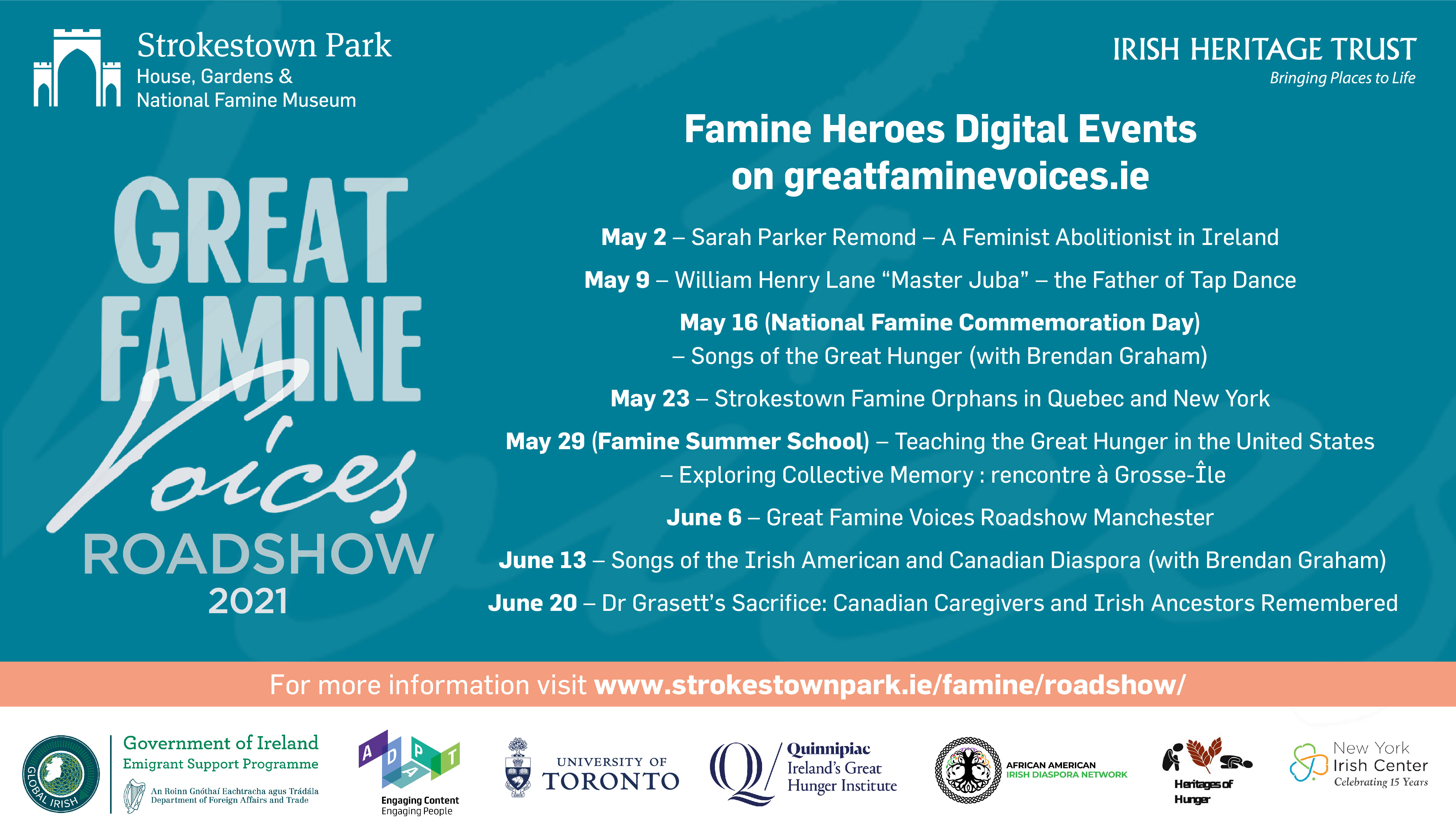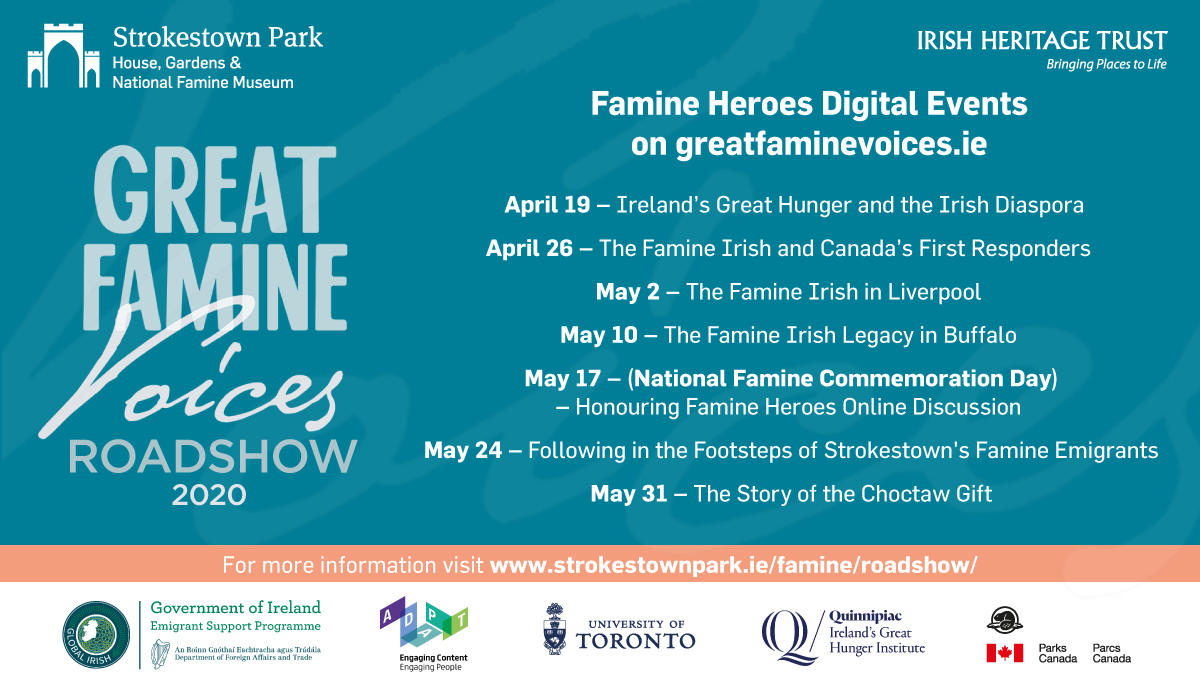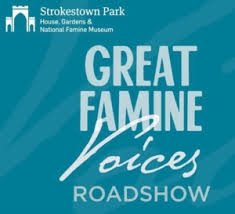
Sarah Parker Remond – A Feminist Abolitionist in Ireland (17:54) tells the story of her visit to Ireland in 1859 to win support for anti-slavery, even as her own country was hurtling towards a bloody civil war. She followed her brother, fellow abolitionist Charles Lenox Remond, who lectured in Ireland on the eve of the Great Famine. A life-long friend of Frederick Douglass, Sarah made her own unique contribution to abolition on both sides of the Atlantic.
William Henry Lane “Master Juba” – the Father of Tap Dance (23:37)
William Henry Lane “Master Juba” – the Father of Tap Dance (23:37). Master Juba is widely recognized as the father of tap dance, yet little is known about his personal life. He visited Ireland in 1849, when the country was slowly emerging from a devastating famine. Juba used his remarkable artistry to challenge stereotypes while also creating a new form of entertainment.
Songs of the Great Hunger (with Brendan Graham) (38:51)
Songs of the Great Hunger (38:51) shares the music of Brendan Graham performed at famine commemoration events in Ireland, Australia, and Canada. Brendan Graham and Eileen Moore Quinn explore the historical experiences of Irish emigrant communities during the Great Hunger that inspired classic songs such as Ochón an Gorta Mór, Crucán na bPáiste, Orphan Girl, The Whitest Flower, and The Voice.
Strokestown Famine Orphans in Quebec and New York (35:14)
Strokestown Famine Orphans in Quebec and New York (35:14) recalls the harrowing journeys of children from rural Roscommon such as Edward Neary, Patrick and Thomas Quinn, and Daniel and Catherine Tighe who crossed the Atlantic in some of the worst coffin ships in 1847 to start new lives in Canada and the United States. Their sorrowful voyages are recounted by their descendants.
Teaching the Great Hunger in the United States (23:23)
Teaching the Great Hunger in the United States (23: 23) is presented by Professor Maureen Murphy who developed the New York State Great Hunger Curriculum and is historian of The Hunger Memorial in New York City. She reflects on teaching the Irish Famine, the Hunger Memorial, and the role of women such as Asenath Nicolson in alleviating hunger and homelessness in the past and present.
Exploring Collective Memory : rencontre à Grosse-Île (32:53)
Great Famine Voices Roadshow Manchester (1:13:21)
Great Famine Voices Roadshow Manchester (1:13:21) tells the story of the Famine Irish migration to the city and legacy of its Irish community. Mervyn Busteed provides a tour of Manchester’s Famine Irish neighborhoods and sites such as Angel Meadow and Little Ireland while recounting the history of the Great Hunger migration to the city in 1847. Mancunians of Irish descent recall their ancestors’ arrival and settlement in these formerly impoverished and now iconic areas.
Songs of the Irish American and Canadian Diaspora (with Brendan Graham) (44:06)
DR GRASETT’S SACRIFICE: CANADIAN CAREGIVERS AND IRISH ANCESTORS REMEMBERED (33:59)
FAMINE HEROES 2020

Ireland’s Great Hunger and the Irish Diaspora (50:08)
Ireland’s Great Hunger and the Irish Diaspora (Rebecca Abbott, Christine Kinealy, Liam O’Brien) explores the historical and socio-political circumstances leading to potato failure, mass starvation and death in Ireland, 1847-52. Narrated by actor Gabriel Byrne, the film includes famine scholars,descendants of famine survivors, emigrants to Quebec, and “Earl Grey” orphan women who emigrated to Australia.
The Famine Irish and Canada’s First Responders (52:04)
The Famine Irish and Canada’s First Responders (directed by Kevin Moynihan) explores Canada’s compassion in welcoming the 109,000 Irish emigrants fleeing the Great Famine in 1847. This film visits Grosse Ile, Montreal and Toronto to understand how the memorials to the Irish Famine help to tell the story of courage and compassion on the part of Canada’s First Responders.
The Famine Irish in Liverpool from the Strokestown Park Estate in 1847 (18:02)
The Story of Famine Irish emigrants from the Strokestown Park estate of Major Denis Mahon (now home of the National Famine Museum) who were forced to emigrate to Liverpool in 1847. An extended excerpt from the Liverpool Irish documentary by Roger Appleton (Brightmoon Media) and Greg Quiery (Liverpool Great Hunger Commemoration Committee) for the Great Famine Voices Roadshow.
By 1846, large numbers of Irish people arrived in Liverpool as they fled the potato blight and growing famine in Ireland. Many went on to Canada, the United States, and elsewhere, but a large number stayed in the city. Dr. Christine Kinealy discusses the events and impact of the Great Hunger in Ireland on the port city of Liverpool in the mid 19th century.
The Famine Irish Legacy in Buffalo, New York (38:20)
National Famine Commemoration Day 2020 Ceremony
See RTE News Coverage of the National Famine Commemoration
Excerpt from Josepha Madigan, T.D., Minister for Culture, Heritage and Gaeltacht’s Address at the National Famine Commemoration Ceremony in St. Stephen’s Green, Dublin, May 17th 2020:
One of the most enduring memories of the international impact of the Great Famine is the contribution to relief by the Choctaw Nation – themselves no strangers to suffering – which has its echo in the contributions by Irish people to recent fund raising initiatives on behalf of Native American communities affected by COVID-19.
Other names that come to mind include the Polish Count Paul Strzelecki who did such important work in so many towns and and Dr. George Robert Grassett in Toronto, and the many doctors and nurses who put themselves at risk to care for the victims who had fled the Famine on the notorious coffin ships. They will always have our thanks for their courage.
As a people, we have through the generations sought to repay the gift of their generosity of spirit by the contribution of our missionaries and aid workers throughout the Developing World. As our society has changed and evolved, this commitment to helping others has never wavered and continues to this day.
In her poem Quarantine, the late Eavan Boland movingly evoked the efforts of a loving husband to support his wife with the last of his strength, when she said:
“She was sick with famine fever and could not keep up.
He lifted her and put her on his back.”
The heroes of the Famine that we honour today also sought to lift and carry those who fell or could not keep up. That same spirit of caring and self sacrifice that is embedded in the caring professions, is being seen again today as our health workers embrace the challenge of caring for those affected by Covid-19.
We honour and respect these modern-day heroes and value their courage. Perhaps we can best show our appreciation for their work, and the efforts of their forebears during the Great Famine, by adhering to those small acts of heroism we are called upon to perform in the response to the Covid-19 pandemic, and to come though these testing times, just as our ancestors once did.
Read Minister Josepha Madigan’s full National Famine Commemoration Speech here.
Following in the Footsteps of Strokestown’s Famine Emigrants (48:53)
Following in the Footsteps of Strokestown’s Famine Emigrants.
A documentary presented by Professor Mark McGowan who follows in the footsteps of emigrants from the Strokestown Park House estate of Major Denis Mahon, now home of the National Famine Museum. They were assisted to emigrate in 1847, though in reality had little choice. He follows in their footsteps along the National Famine Way walking trail on the banks of the Royal Canal to Dublin, and then on to Grosse Île and the Irish Memorial National Historic Site and the Niagara region in Canada.
The Story of the Choctaw Gift (28:40)
The Story of the Choctaw Gift
A documentary about the Choctaw donation for Irish Famine relief in 1847 shortly after the Choctaw people themselves were expelled from their traditional homelands and forced to embark on the Trail of Tears to Oklahoma. It features a musical performance of The Gift in the National Famine Museum at Strokestown Park. Professor LeAnne Howe (University of Georgia and member of the Choctaw Nation), Professor Christine Kinealy (Quinnipiac University), and Dr Padraig Kirwan (Goldsmiths, University of London) share this riveting story of compassion, indigenous cultural values of giving, reciprocity, and the musical performance of cultural memory.

Montreal’s Grey Nuns and the Great Hunger (32:42)
In 1847, approximately 75,000 people fled across the Atlantic from famine-stricken Ireland to Montreal. Those suffering from infectious diseases such as typhus were cared for in the city’s fever sheds by the Grey Nuns or Sisters of Charity. The most detailed and evocative eyewitness accounts of the suffering of Famine emigrants in North America can be found in their annals. Discover the stories of James Flood from Strokestown and Rose Brown from Galway who were cared for by the Grey Nuns after losing their parents. Learn about the miracle of Rose’s marble which led to her reunification with her mother and vocation to join the Grey Nuns as Sister St. Patrice. Over six thousand Irish emigrants are buried in Montreal, the largest Famine Irish mass grave outside of Ireland, which is marked by the Black Rock memorial. This burial ground has been recently excavated. The film pays tribute to Montreal’s Famine Irish and their Canadian caregivers.
Count Strzelecki’s Legacy: A Polish Irish Famine Hero (19:31)
Frederick Douglass in Ireland (27:48)
The film gives an overview of Frederick Douglass’s life-changing time spent in Ireland at the beginning of the Great Famine in 1845-1846. Irish actor Kwaku Fortune reflects on Douglass’s legacy for new communities in Ireland.
Great Famine Voices Liverpool Irish Festival (44:46)
Remembering James Hack Tuke: Emigrant Descendants (29:00)
Emigrant descendants of James Hack Tuke’s migration schemes from Counties Galway and Mayo during the “Forgotten Famine” of 1879-1882 pay tribute to the Quaker Philanthropist who rescued their ancestors from poverty to start news lives overseas.
